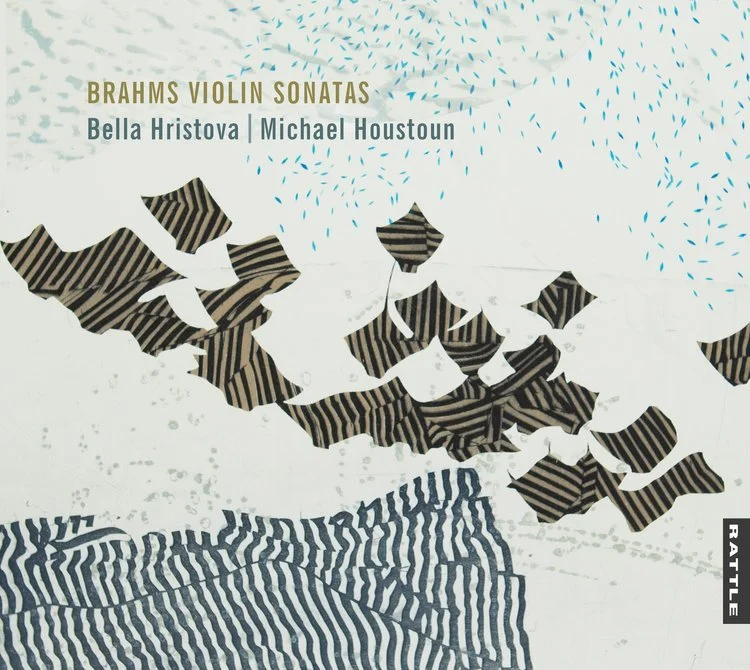Brahms, Hristova and Houstoun: magical unanimity
Pianist Michael Houstoun and violinist Bella Hristova
…bringing their effortless rapport to the music of Brahms.
An album of Brahms Violin Sonatas was released by Rattle late last year, featuring Bulgarian-American violinist Bella Hristova with Michael Houstoun, New Zealand pianist. It reveals a shared conception of the music and what Hristova described once as their "magical unspoken musical understanding". Their understated approach, full of melodious loveliness and subtle virtuosity, is ideally suited to the music of Brahms, a composer who expresses deep romantic emotions while maintaining classical restraint and structures.
The two musicians first met when Hristova won First Prize in the Michael Hill International Violin Competition in 2007. Winners were awarded a ten-concert tour with Chamber Music New Zealand and Hristova toured very successfully with Houstoun, the pair finding an effortless rapport in a programme that included Beethoven’s ‘Kreutzer’ Sonata. They joined forces again in 2017 for concerts in New Zealand, this time for Beethoven's complete Violin Sonatas, the 4-CD set of their subsequent recording of these winning the award for Best Classical Artist at the 2019 New Zealand Music Awards.
In the latest album, the singing beauty of Hristova’s approach to melody shines from the opening movement of Brahms’ Sonata No 1 in G major, underlined by Houstoun’s gentle piano. Impassioned moments return to a dreamy quietness. The Adagio 2nd movement is more solemn, Brahms holding the violin back as the piano rolls underneath like a deep river. This movement requires frequent double-stopping from the violin, always deftly managed by this sure performer. The well-matched, warm-toned conversation, with moments of emotional drama, continues in the more sprightly Allegro molto moderato of the 3rd movement, technical demands always subsumed into effortless momentum.
Brahms offers clear interpretative intentions in his 2nd Violin Sonata, the first movement marked “amabile” (lovingly), the second, “tranquillo” (tranquil) and the third “grazioso” (graceful). Hristova and Houstoun let the music create its own emotional impact with unobtrusive romantic warmth; Brahms’ loving intent and occasional yearning need no heavy underlining.
Passion blooms at the end of the first movement before a peaceful slow movement with alternating bouncier episodes. Both musicians bring a beguiling lightness to this music, including whimsical pizzicato from Hristova and a final rapid little bounce at the movement’s end. Their thoughtful approach and emotional restraint in the graceful third movement is also entirely convincing – surely this is exactly what Brahms would have wanted.
Johannes Brahms
“…ardent emotions reigned into a marvellous structure.”
His big four-movement Sonata No 3, D minor Opus 108 is a different story. Hristova describes the work as “vast and turbulent” and in the long first movement we find Brahms closer to Beethoven’s model, forthright and expansive with restless emotions - there’s nothing “tranquillo” here. Again the virtuosic demands are dealt with effortlessly by the musicians, all focus on the moody, brooding drama.
Houstoun’s piano in the solemn Adagio is warm in the deep-toned opening, with Hristova’s subtle vibrato beautifully expressive in the violin’s alto register. The mood lightens in the mercurial third movement, Un poco presto e con sentimento; there’s whimsy in the rhythm and metre but a catch in the throat of Brahms’ “sentimento”. The musicians enjoy the conversation, finding a sense of fun as the piano ripples against little violin figures, a touch of humour before what Houstoun describes as the “tour de force” of the 4th movement.
This final Presto agitato shows Brahms the Romantic-Classicist at work, ardent emotions reigned into a marvellous structure. Houstoun and Hristova deal with his precipitous rhythmic invention with great facility and thrilling unanimity, finding lyricism as well in this dark movement as they dash to the passionate ending of a brilliant Sonata.
In 2022 Rattle released, to mark Houstoun's 70th birthday, his recording of The Complete Intermezzi by Brahms, a collection of short musical delights best enjoyed, as I wrote at the time, "in the thoughtful mood so beautifully expressed by composer and pianist." This return to Brahms, in the more substantial fare of the Violin Sonatas and in graceful partnership with Hristova, is a fine addition to Houstoun’s discography. “Our recording of them”, Houstoun says, “was one of the happiest and most fulfilling experiences of my musical life."
BRAHMS VIOLIN SONATAS
Bella Hristova (Violin) and Michael Houstoun (Piano)
Rattle (purchase here)
Footnote: A few years ago Houstoun, one of New Zealand's most beloved pianists, announced retirement plans. The news was met with dismay. Then, in 2020, supposedly the last year he would perform publicly, the pandemic disrupted concert schedules and closed borders. No international artists were able to fulfil performing commitments in New Zealand, and local soloists had a busy year. Houstoun withdrew his retirement plans and now says, to the relief of many, that he’ll continue to accept invitations to perform.
In more good news, an album from Rattle of French music recorded by Hristova and Houstoun is scheduled for release this year. As well, solo albums from Houstoun in the Rattle pipeline include music by Chinese-New Zealand composer Gao Ping and a “favourites” album including music by Ravel.
You can read my Five Lines album reviews of Hristova and Houstoun’s Complete Beethoven Sonatas here and of Houstoun’s Brahms Complete Intermezzi here.
[Album purchase links included.)



